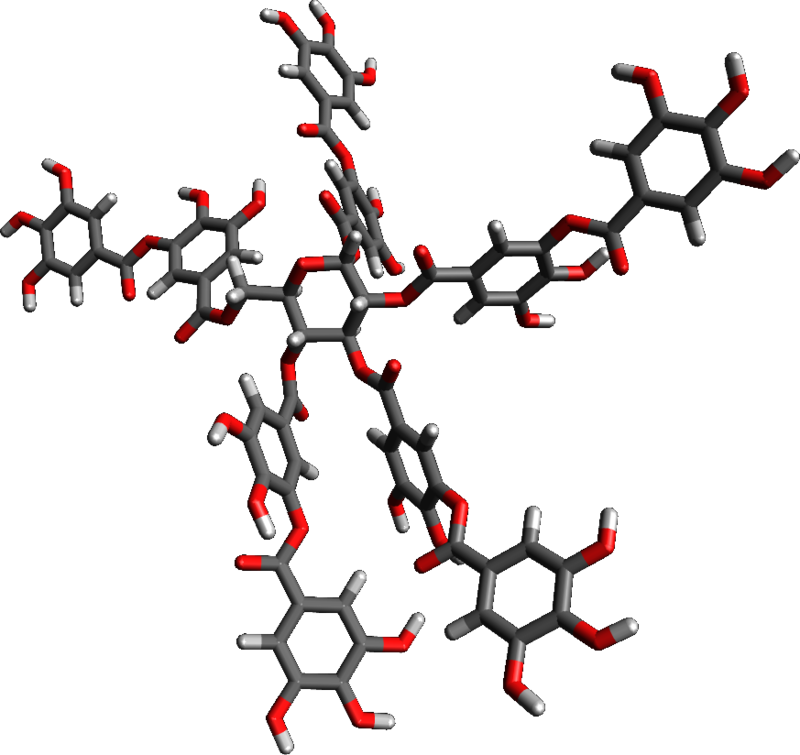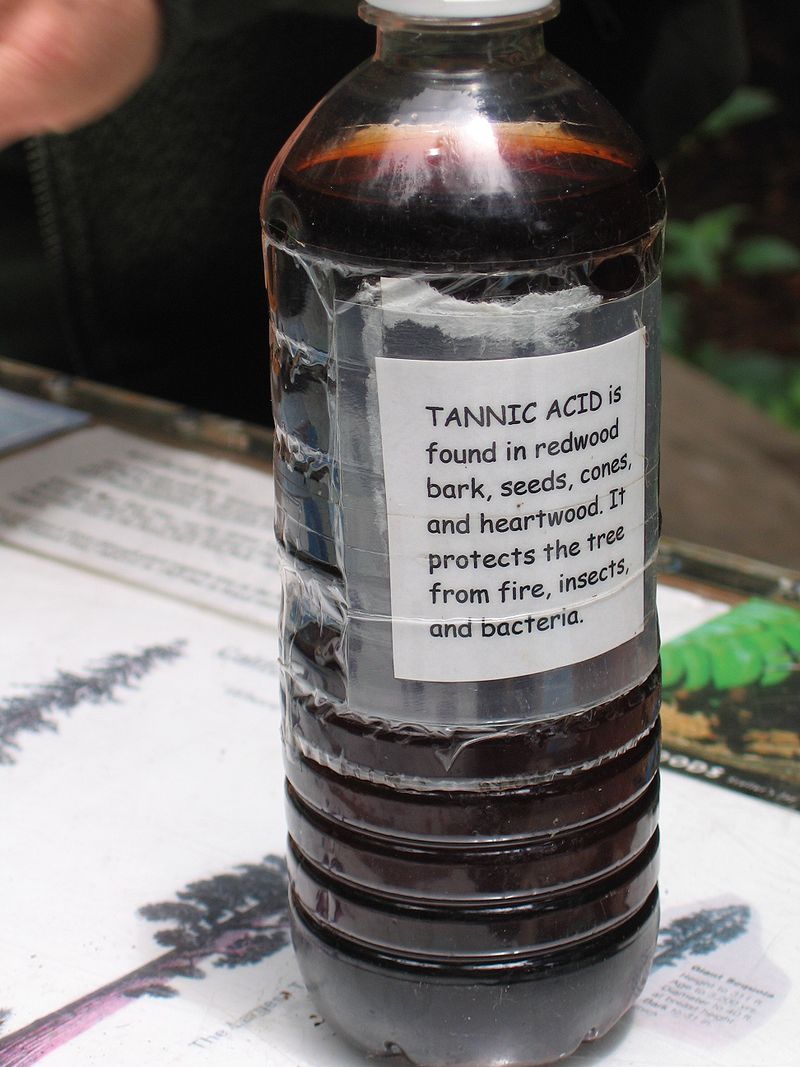Tannic acid
Tannic acid
Tannic acid represents a distinct variant of tannin, falling under the polyphenol category. Its relatively mild acidity, characterized by a pKa of approximately 6, can be attributed to the abundance of phenolic groups within its molecular structure. The chemical composition often attributed to commercial tannic acid is C76H52O46, corresponding to decagalloyl glucose. However, it's essential to note that tannic acid is actually a blend of polygalloyl glucoses or polygalloyl quinic acid esters, with the number of galloyl moieties per molecule varying between 2 and 12, depending on the plant source from which it is derived. Typical sources for commercial tannic acid extraction include Tara pods (Caesalpinia spinosa), gallnuts from Rhus semialata or Quercus infectoria, and Sicilian sumac leaves (Rhus coriaria).
To adhere to precise definitions found in external references such as international pharmacopoeia, Food Chemicals Codex, and the FAO-WHO tannic acid monograph, it's crucial to classify tannic acid exclusively when derived from the aforementioned plant sources. Descriptions of tannic acid extracted from chestnut or oak wood are, in fact, misuses of the term. Tannic acid typically presents as a powder with shades ranging from yellow to light brown and possesses an amorphous nature.
It's important to acknowledge that tannic acid, while a specific form of tannin, is often erroneously used interchangeably with the broader term "tannin." This persistent confusion has been perpetuated in scholarly literature, especially concerning green tea and black tea, both of which contain a diverse array of tannins beyond just tannic acid.
Due to its ill-defined composition, tannic acid is unsuitable as a standard for any tannin analysis.

Quercitannic acid and gallotannic acid
Quercitannic acid and gallotannic acid are two distinct forms of tannic acid compounds. Quercitannic acid is primarily found in oak bark and leaves, while gallotannic acid is typically present in oak galls.
The quercitannic acid molecule is also a component of quercitron, a yellow dye derived from the bark of the Eastern black oak (Quercus velutina), a native tree species in North America. It is described as an amorphous powder with a yellowish-brown hue.
In 1838, J?ns Jacob Berzelius noted the use of quercitannate in dissolving morphine.
In 1865, Henry Watts, in the fifth volume of "A dictionary of chemistry," observed that quercitannic acid exhibited reactions with ferric salts similar to gallotannic acid. However, it differed in that it couldn't be converted into gallic acid and didn't yield pyrogallic acid through dry distillation. It precipitated when exposed to sulfuric acid, forming red flocks.
According to Rochleder, the tannic acid found in black tea was the same as that in oak bark.
In 1880, Etti proposed a molecular formula of C17H16O9 for quercitannic acid, describing it as an unstable substance that had a tendency to release water, forming anhydrides, one of which was called oak-red (C34H30O17). Etti did not classify it as a glycoside.
In Allen's "Commercial Organic Analysis," published in 1912, a formula of C19H16O10 was suggested for quercitannic acid.
Different authors have proposed various molecular formulas, such as C28H26O15 and C28H24O11.
Lowe suggested the existence of two forms of the compound, one soluble in water (C28H28O14) and the other scarcely soluble (C28H24O12), both of which could be converted into oak red (C28H22O11) by losing water.
At one point in history, quercitannic acid served as a standard for assessing phenolic content in spices, denoted as quercitannic acid equivalent.
In an intriguing historical note, Edward G. Acheson, the inventor of carborundum, discovered that gallotannic acid significantly enhanced the plasticity of clay. He pointed out that the use of organic material mixed with clay, as described in the Bible (Exodus 1:11), may have been related to the Egyptians' awareness of this method, considering the effectiveness of substituting stubble for straw when the extract of the plant was used as a binding agent for clay.
Uses
Tannins play a fundamental role in the chemical staining of wood, already naturally occurring in woods such as oak, walnut, and mahogany. Tannic acid can be applied to woods with low tannin content to enable chemical stains that rely on tannins to react. The presence of tannins in redwood bark (Sequoia) serves as a robust natural defense against elements like wildfire, decomposition, and certain insects, including termites. Tannic acid can be found in the seeds, bark, cones, and heartwood of these trees.
In the realm of textile dyeing, tannic acid is a common mordant for cellulose fibers, particularly cotton, often combined with alum and/or iron. It is recommended to use the tannin mordant first, as it pairs well with metal mordants within the fiber-tannin complex. However, this application has waned in popularity over time.
Similarly, tannic acid can enhance the wash fastness of acid-dyed polyamide and serve as an alternative to fluorocarbon aftertreatments for imparting anti-staining properties to polyamide yarn or carpets. Presently, its primary use in the textile industry is to improve chlorine fastness, safeguarding against dye bleaching when exposed to hypochlorite solutions in high-end polyamide 6,6-based carpets and swimwear. It is also employed in small quantities for upholstery flock activation, functioning as an anti-static treatment.
Tannic acid is an essential component in the conservation of ferrous (iron-based) metal objects, where it passivates and inhibits corrosion. This substance reacts with corrosion products to form a more stable compound, effectively preventing further corrosion. After treatment, tannic acid residue is often left on the object, poised to rehydrate and thwart any corrosion should moisture reach the surface. It's a highly effective method but does alter the visual appearance of the object, turning corrosion products black and exposed metal dark blue. Caution is advised when using it on objects with copper alloy components, as it may slightly etch these metals.
Tannic acid is also found in commercial iron/steel corrosion treatments, including products like Hammerite Kurust.

Use in food
In the realm of food, tannic acid is permitted for use in many parts of the world. In the United States, the Food and Drug Administration recognizes it as safe for incorporation into baked goods, alcoholic and non-alcoholic beverages, frozen dairy products, soft and hard candy, meat products, and rendered animal fat.

Uses as a medication
As a medication, tannic acid was historically used in conjunction with magnesium and sometimes activated charcoal to treat various toxic substances, including strychnine, mushroom, and ptomaine poisonings in the late 19th and early 20th centuries. It was also applied in the treatment of severe burn injuries during the 1920s, significantly reducing mortality rates. However, its use in this context has since been supplanted by more modern treatment approaches.
Hazards
Regarding potential hazards, tannic acid could pose health risks, such as eye, skin, respiratory tract, and gastrointestinal tract damage. It may lead to irritation, redness, pain, blurred vision, and potential eye damage when exposed to the eyes. Skin absorption in excessive amounts may result in skin irritation, redness, and pain. Ingestion of tannic acid can lead to symptoms like nausea, vomiting, and diarrhea, with prolonged exposure potentially causing liver damage. Inhalation of tannic acid may result in respiratory tract irritation.
Crocodilian coloration
In the context of crocodilian coloration, the color of crocodile and alligator skin is significantly influenced by water quality. Algae-rich waters produce greener skin, while the presence of tannic acid in water from decaying leaves, often found in certain types of blackwater rivers, can darken the skin of these reptiles.